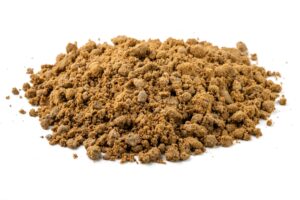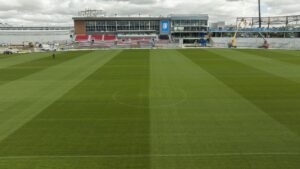Clay is a versatile building aggregate with various applications in construction and landscaping due to its unique properties, including its ability to provide stability, shape landscapes, and act as a waterproof lining. Key Applications for Clay as a Building Aggregate:
Building Foundations: Clay serves as a crucial material for building foundations. Its cohesive and load-bearing properties make it an ideal choice for providing a stable and robust base upon which the entire structure can rest securely.
Earthworks and Embankments: In construction projects requiring earthworks, such as road construction or reservoir development, clay plays a vital role. It can be used to construct embankments, earth berms, and engineered slopes, contributing to the overall stability and safety of the project.
Landscaping: Clay finds valuable use in landscaping projects, helping shape the terrain and create planting areas. Its malleability allows for precise sculpting of outdoor spaces, enhancing their aesthetic appeal and functionality.
Retention Ponds: In civil engineering and environmental projects, clay lines retention ponds and other water containment structures. Its impermeable nature effectively prevents water seepage, ensuring these structures’ integrity and ability to retain water as needed.
Applications
Building Foundations: Clay can be used as a foundation material for buildings, providing a stable and load-bearing base for the structure.
Earthworks and Embankments: Clay can be used to create embankments, earth berms, and engineered slopes in various construction projects.
Landscaping: Clay can be used in landscaping projects to shape the terrain, create planting areas, and support outdoor features.
Retention Ponds: In civil engineering, clay can be used to line retention ponds and other water containment structures.
Benefits
Using Clay in Construction Projects:
Load-Bearing Capacity: Clay exhibits impressive load-bearing capacity, making it a reliable choice for supporting the weight of structures and foundations.
Cohesion and Compaction: Clay forms a solid and stable foundation when compacted correctly. Its innate cohesion helps prevent settling and shifting, ensuring long-term structural integrity.
Water Retention: Clay’s ability to retain water proves advantageous in maintaining optimal soil moisture levels around foundations, contributing to foundation stability.
Natural Insulation: Clay possesses thermal insulating properties that aid in regulating temperatures around foundations. Natural insulation can reduce heating and cooling expenses.
Erosion Control: Clay is effective in erosion control measures due to its cohesive properties. It plays a vital role in stabilizing slopes and embankments, reducing the risk of erosion-related damage.
Abundance and Accessibility: Clay is readily available in many regions, making it a convenient and cost-effective foundation material accessible to construction projects.
Reduced Settlement: Proper compaction of clay minimizes foundation settlement and mitigates uneven settlement of structures, ensuring structural stability over time.
Cost-Effective: Utilizing clay as a foundation material often proves cost-effective, especially when sourced locally, reducing the need for specialized and expensive materials.
Compatibility with Local Soil: Clay may align with the existing soil composition in the area, providing a consistent and stable foundation material that complements the local environment.
Sustainability: Employing locally sourced clay contributes to sustainability efforts by reducing transportation needs and minimizing the environmental impact of material transportation.
It’s essential to acknowledge that while clay offers numerous benefits, it also presents challenges. Factors such as its expansion and contraction with moisture variations can lead to foundation movement, and shrinkage when drying can result in cracks. Comprehensive soil testing, engineering analysis, and thoughtful foundation design are imperative to harness clay’s advantages effectively and address potential issues. Collaboration with geotechnical engineers and construction professionals ensures the proper and strategic use of clay in foundation applications.
Products
More like this

Type B Fill
Type B fill is frequently employed as a lightweight backfill material for constructing retaining walls and embankments, particularly in situations involving weaker soils. The term “Type B fill” designates a specialized category...

Type A Fill
Type A fill refers to a specific classification of engineered fill material commonly used in construction projects, providing a stable and compacted base for various structures.Type A material, known for its low permeability, is positioned...

Tailings
Tailings are the waste materials left behind after extracting valuable minerals from ores in industries like mining and mineral extraction. These residual materials consist of finely ground particles, often in a slurry form, and vary in...

Mud Stone
Mudstone is a type of sedimentary rock that is composed of fine-grained particles, including clay minerals and silt, derived from the settling of clay in calm water bodies. It forms through the accumulation and compaction of these small...

Clean Fill
“Clean fill” is a fundamental term in the construction industry, denoting earth materials, such as soil, rock, sand, gravel, or similar substances, that are devoid of contaminants, debris, or hazardous elements.

Clay Overburden
Clay overburden is the stratum of clay-rich material that frequently overlays valuable subterranean resources or mineral deposits. Typically, it is extracted and temporarily relocated during mining or excavation operations to facilitate...

Capping Clay
“Capping clay” refers to a particular variety of clay that develops a natural firm, solid layer or crust on the soil’s surface following periods of rainfall or irrigation as it dries.

Case
studies

Normark
Established in 1977, Normark are a second generation family business specialising in landscape design and construction across Melbourne. "From inner-city Melbourne courtyards to large commercial open spaces, Normark will deliver."

Normark
Established in 1977, Normark are a second generation family business specialising in landscape design and construction across Melbourne. "From inner-city Melbourne courtyards to large commercial open spaces, Normark will deliver."

Normark
Established in 1977, Normark are a second generation family business specialising in landscape design and construction across Melbourne. "From inner-city Melbourne courtyards to large commercial open spaces, Normark will deliver."

Normark
Established in 1977, Normark are a second generation family business specialising in landscape design and construction across Melbourne. "From inner-city Melbourne courtyards to large commercial open spaces, Normark will deliver."

Normark
Established in 1977, Normark are a second generation family business specialising in landscape design and construction across Melbourne. "From inner-city Melbourne courtyards to large commercial open spaces, Normark will deliver."


